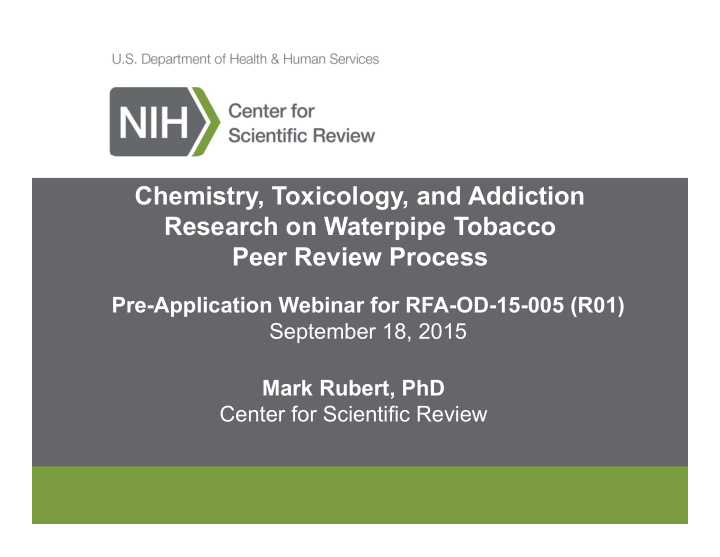



Chemistry, Toxicology, and Addiction Research on Waterpipe Tobacco Peer Review Process Pre-Application Webinar for RFA-OD-15-005 (R01) September 18, 2015 Mark Rubert, PhD Center for Scientific Review
Key Dates for Application Review • Letter of Intent Due – October 13, 2015 • Application Due – November 20, 2015 • Scientific Merit Review – March 2016 • Advisory Council Review – May 2016 • Earliest Start Date – July 2016
Peer Review Principles • Applications will be evaluated for scientific and technical merit by (an) appropriate Scientific Review Group(s) convened by the Center for Scientific Review – Persons in Conflict with the application will be excluded – Reviewers will have relevant research expertise and few (if any) will be federal employees (e.g., VA, CDC) – Standard NIH review procedures will be used, and every applicant will receive written feedback (a “summary statement”)
Scored Review Criteria (same as listed in FOA) Overall Impact Reviewers provide an overall priority score to reflect their assessment of the likelihood for the project to exert a sustained, powerful influence on the research field(s) in consideration of the following review criteria and additional review criteria
Scored Review Criteria (same as listed in FOA) Significance Does the project address an important issue or a critical barrier in the field? If the aims of the project are achieved, how will scientific knowledge and/or technical capability be improved? How will successful completion of the aims affect the concepts, methods, and technologies related to the manufacture, distribution, and marketing of tobacco products?
Scored Review Criteria (cont.) Investigator(s) Are the PD(s)/PI(s), collaborators, and other researchers well suited to the project? If Early Stage Investigators or New Investigators, or in the early stages of independent careers, do they have appropriate experience and training? If established, have they demonstrated an ongoing record of accomplishments that have advanced their field(s)? If the project is collaborative or multi-PD/PI, do the investigators have complementary and integrated expertise; are their leadership approach, governance and organizational structure appropriate for the project?
Scored Review Criteria (cont.) Innovation Does the application challenge and seek to shift current research in the field of tobacco science as it relates to the manufacture, distribution, and marketing of tobacco products? Is a refinement, improvement, or new application of theoretical concepts, approaches or methodologies, or instrumentation proposed? Will the outcomes of the project provide new information to further develop the knowledge base that informs the manufacture, distribution, and marketing of tobacco products in order to protect public health?
Scored Review Criteria (cont.) Approach Are the overall strategy, methodology, and analyses well-reasoned and appropriate to accomplish the specific aims of the project? Are potential problems, alternative strategies, and benchmarks for success presented? If the project is in the early stages of development, will the strategy establish feasibility and will particularly risky aspects be managed?
Scored Review Criteria (cont.) Approach (cont.) If the project involves clinical research, are the plans for 1) protection of human subjects from research risks, and 2) inclusion of minorities and members of both sexes/genders, as well as the inclusion of children, justified in terms of the scientific goals and research strategy proposed?
Scored Review Criteria (cont.) Environment Will the scientific environment in which the work will be done contribute to the probability of success? Are the institutional support, equipment and other physical resources available to the investigators adequate for the project proposed? Will the project benefit from unique features of the scientific environment, subject populations, or collaborative arrangements
Additional Review Criteria: SCORABLE – Protection of Human Subjects – Inclusion of Women, Minorities & Children – Vertebrate Animals – Biohazards
Impact Scores • For reviewers, the NIH scale is 1-9, in integers, with 1 being best, highest priority • All eligible reviewers vote: the average score is multiplied by 10, and rounded to the nearest integer, giving impact scores from 10-90, 10 being the best overall score • Only those applications deemed to have the highest scientific and technical merit (generally the top half of applications under review) will be discussed and assigned an overall impact score .
Additional Review Criteria: NOT Scorable (Reviewers will comment but not factor into theirs scores) • Select agent research • Resource sharing plans • Budget & period of support • Foreign applications – relevant to U.S. population and regulation
Review Contact • If you have additional questions about the review process for these applications, please contact: Mark Rubert, PhD Rubertm@csr.nih.gov 301 806-6596
Recommend
More recommend